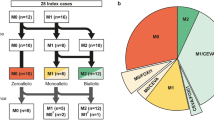Abstract
Objectives
The identification of gene mutations enables more appropriate genetic counseling and proper medical management for EVA patients. The purpose of this study was to validate the accuracy and sensitivity of our method for comprehensive mutation detection in EVA, and summarize these data to explore a more accurate and convenient genetic diagnosis method.
Methods
A multiplex PCR sequencing panel was designed to capture the exons of three known EVA-associated genes (SLC26A4, KCNJ10, and FOXI1), and NGS was conducted in 17 Chinese families with EVA.
Results
A total of 16 SLC26A4 variants were found in 21 probands with bilateral EVA, including three novel variants (c.416G>A, c.823G>A and c.1027G>C), which were not reported in the dbSNP, gnomAD database, and ClinVar databases. One patient carried a FOXI1 variant (heterozygous, c.214C>A) and one patient carried a KCNJ10 variant (heterozygous, c.1054C>A), both of which were novel variants. Biallelic potential pathogenic variants were detected in 21/21patient samples, leading to a purported diagnostic rate of 100%. All results were verified by Sanger sequencing.
Conclusion
This result supplemented the mutation spectrum of EVA, and supports that combined multiple PCR-targeted enrichment, and NGS is a valuable molecular diagnostic tool for EVA, and is suitable for clinical application.



Similar content being viewed by others
References
Ito T, Choi BY, King KA, Zalewski CK, Muskett J, Chattaraj P, Shawker T, Reynolds JC, Butman JA, Brewer CC, Wangemann P, Alper SL, Griffith AJ (2011) SLC26A4 genotypes and phenotypes associated with enlargement of the vestibular aqueduct. Cell Physiol Biochem 28(3):545–552. https://doi.org/10.1159/000335119
Tsukamoto K, Suzuki H, Harada D, Namba A, Abe S, Usami S (2003) Distribution and frequencies of PDS (SLC26A4) mutations in Pendred syndrome and nonsyndromic hearing loss associated with enlarged vestibular aqueduct: a unique spectrum of mutations in Japanese. Eur J Hum Genet 11(12):916–922. https://doi.org/10.1038/sj.ejhg.5201073
Pera A, Dossena S, Rodighiero S, Gandia M, Botta G, Meyer G, Moreno F, Nofziger C, Hernandez-Chico C, Paulmichl M (2008) Functional assessment of allelic variants in the SLC26A4 gene involved in Pendred syndrome and nonsyndromic EVA. Proc Natl Acad Sci USA 105(47):18608–18613. https://doi.org/10.1073/pnas.0805831105
Yang T, Vidarsson H, Rodrigo-Blomqvist S, Rosengren SS, Enerback S, Smith RJ (2007) Transcriptional control of SLC26A4 is involved in Pendred syndrome and nonsyndromic enlargement of vestibular aqueduct (DFNB4). Am J Hum Genet 80(6):1055–1063. https://doi.org/10.1086/518314
Liu Y, Wang L, Feng Y, He C, Liu D, Cai X, Jiang L, Chen H, Liu C, Wu H, Mei L (2016) A new genetic diagnostic for enlarged vestibular aqueduct based on next-generation sequencing. PLoS ONE 11(12):e0168508. https://doi.org/10.1371/journal.pone.0168508
Yang T, Gurrola JG 2nd, Wu H, Chiu SM, Wangemann P, Snyder PM, Smith RJ (2009) Mutations of KCNJ10 together with mutations of SLC26A4 cause digenic nonsyndromic hearing loss associated with enlarged vestibular aqueduct syndrome. Am J Hum Genet 84(5):651–657. https://doi.org/10.1016/j.ajhg.2009.04.014
Huijun Y, Yu L (2014) Application of next generation sequencing in gene identification and genetic diagnosis of hereditary hearing loss. Yi Chuan 36(11):1112–1120. https://doi.org/10.3724/SP.J.1005.2014.1112
Yan D, Tekin M, Blanton SH, Liu XZ (2013) Next-generation sequencing in genetic hearing loss. Genet Test Mol Biomarkers 17(8):581–587. https://doi.org/10.1089/gtmb.2012.0464
Tekin D, Yan D, Bademci G, Feng Y, Guo S, Foster J 2nd, Blanton S, Tekin M, Liu X (2016) A next-generation sequencing gene panel (MiamiOtoGenes) for comprehensive analysis of deafness genes. Hear Res 333:179–184. https://doi.org/10.1016/j.heares.2016.01.018
Madden C, Halsted M, Benton C, Greinwald J, Choo D (2003) Enlarged vestibular aqueduct syndrome in the pediatric population. Otol Neurotol 24(4):625–632. https://doi.org/10.1097/00129492-200307000-00016
Adzhubei I, Jordan DM, Sunyaev SR (2013) Predicting functional effect of human missense mutations using PolyPhen-2. Curr Protoc Hum Genet Chapter 7(Unit7):20. https://doi.org/10.1002/0471142905.hg0720s76
Ng PC, Henikoff S (2003) SIFT: Predicting amino acid changes that affect protein function. Nucleic Acids Res 31(13):3812–3814. https://doi.org/10.1093/nar/gkg509
Schwarz JM, Rodelsperger C, Schuelke M, Seelow D (2010) MutationTaster evaluates disease-causing potential of sequence alterations. Nat Methods 7(8):575–576. https://doi.org/10.1038/nmeth0810-575
Friedman J, Smith DE, Issa MY, Stanley V, Wang R, Mendes MI, Wright MS, Wigby K, Hildreth A, Crawford JR, Koehler AE, Chowdhury S, Nahas S, Zhai L, Xu Z, Lo WS, James KN, Musaev D, Accogli A, Guerrero K, Tran LT, Omar TEI, Ben-Omran T, Dimmock D, Kingsmore SF, Salomons GS, Zaki MS, Bernard G, Gleeson JG (2019) Biallelic mutations in valyl-tRNA synthetase gene VARS are associated with a progressive neurodevelopmental epileptic encephalopathy. Nat Commun 10(1):707. https://doi.org/10.1038/s41467-018-07067-3
Landrum MJ, Lee JM, Riley GR, Jang W, Rubinstein WS, Church DM, Maglott DR (2014) ClinVar: public archive of relationships among sequence variation and human phenotype. Nucleic Acids Res 42(Database issue):D980–D985. https://doi.org/10.1093/nar/gkt1113
Wu H, Feng Y, Jiang L, Pan Q, Liu Y, Liu C, He C, Chen H, Liu X, Hu C, Hu Y, Mei L (2016) Application of a new genetic deafness microarray for detecting mutations in the deaf in China. PLoS ONE 11(3):e0151909. https://doi.org/10.1371/journal.pone.0151909
Liu Y, Hu C, Liu C, Liu D, Mei L, He C, Jiang L, Wu H, Chen H, Feng Y (2019) A rapid improved multiplex ligation detection reaction method for the identification of gene mutations in hereditary hearing loss. PLoS ONE 14(4):e0215212. https://doi.org/10.1371/journal.pone.0215212
Miyagawa M, Nishio SY, Usami S, Deafness Gene Study C (2014) Mutation spectrum and genotype–phenotype correlation of hearing loss patients caused by SLC26A4 mutations in the Japanese: a large cohort study. J Hum Genet 59(5):262–268. https://doi.org/10.1038/jhg.2014.12
Park HJ, Lee SJ, Jin HS, Lee JO, Go SH, Jang HS, Moon SK, Lee SC, Chun YM, Lee HK, Choi JY, Jung SC, Griffith AJ, Koo SK (2005) Genetic basis of hearing loss associated with enlarged vestibular aqueducts in Koreans. Clin Genet 67(2):160–165. https://doi.org/10.1111/j.1399-0004.2004.00386.x
Usami S, Abe S, Weston MD, Shinkawa H, Van Camp G, Kimberling WJ (1999) Non-syndromic hearing loss associated with enlarged vestibular aqueduct is caused by PDS mutations. Hum Genet 104(2):188–192. https://doi.org/10.1007/s004390050933
Reiisi S, Sanati MH, Tabatabaiefar MA, Ahmadian S, Reiisi S, Parchami S, Porjafari H, Shahi H, Shavarzi A, Hashemzade Chaleshtori M (2014) The Study of SLC26A4 gene causing autosomal recessive hearing loss by linkage analysis in a cohort of Iranian Populations. Int J Mol Cell Med 3(3):176–182
Van Hauwe P, Everett LA, Coucke P, Scott DA, Kraft ML, Ris-Stalpers C, Bolder C, Otten B, de Vijlder JJ, Dietrich NL, Ramesh A, Srisailapathy SC, Parving A, Cremers CW, Willems PJ, Smith RJ, Green ED, Van Camp G (1998) Two frequent missense mutations in Pendred syndrome. Hum Mol Genet 7(7):1099–1104. https://doi.org/10.1093/hmg/7.7.1099
Jonard L, Niasme-Grare M, Bonnet C, Feldmann D, Rouillon I, Loundon N, Calais C, Catros H, David A, Dollfus H, Drouin-Garraud V, Duriez F, Eliot MM, Fellmann F, Francannet C, Gilbert-Dussardier B, Gohler C, Goizet C, Journel H, Mom T, Thuillier-Obstoy MF, Couderc R, Garabedian EN, Denoyelle F, Marlin S (2010) Screening of SLC26A4, FOXI1 and KCNJ10 genes in unilateral hearing impairment with ipsilateral enlarged vestibular aqueduct. Int J Pediatr Otorhinolaryngol 74(9):1049–1053. https://doi.org/10.1016/j.ijporl.2010.06.002
Landa P, Differ AM, Rajput K, Jenkins L, Bitner-Glindzicz M (2013) Lack of significant association between mutations of KCNJ10 or FOXI1 and SLC26A4 mutations in Pendred syndrome/enlarged vestibular aqueducts. BMC Med Genet 14:85. https://doi.org/10.1186/1471-2350-14-85
Alexander RT, Law L, Gil-Pena H, Greenbaum LA, Santos F (1993) Hereditary distal renal tubular acidosis. In: Adam MP, Ardinger HH, Pagon RA et al (eds) GeneReviews((R)). University of Washington, Seattle, WA
Hulander M, Kiernan AE, Blomqvist SR, Carlsson P, Samuelsson EJ, Johansson BR, Steel KP, Enerback S (2003) Lack of pendrin expression leads to deafness and expansion of the endolymphatic compartment in inner ears of Foxi1 null mutant mice. Development 130(9):2013–2025. https://doi.org/10.1242/dev.00376
Zhao J, Yuan Y, Huang S, Huang B, Cheng J, Kang D, Wang G, Han D, Dai P (2014) KCNJ10 may not be a contributor to nonsyndromic enlargement of vestibular aqueduct (NSEVA) in Chinese subjects. PLoS ONE 9(11):e108134. https://doi.org/10.1371/journal.pone.0108134
Shilton H, Hodgson M, Burgess G (2014) Hyperbaric oxygen therapy for sudden sensorineural hearing loss in large vestibular aqueduct syndrome. J Laryngol Otol 128(Suppl 1):S50–54. https://doi.org/10.1017/S0022215113001308
Funding
This study was funded by grants from the National Natural Science Foundation of China (Grant No. 81771023), the Postdoctoral Research Foundation of China (No. 2017M620359) and the Natural Science Foundation of Hunan Province (No. 2018JJ2634).
Author information
Authors and Affiliations
Contributions
Conceptualization: YLL, YF; Methodology: YYL; Formal analysis and investigation: YYL, JW; Writing—original draft preparation: YYL; Pedigrees collection: SSS, LYM, CFH and LJ; Supervision: YF, LYM. All authors have read and approved the final manuscript.
Corresponding author
Ethics declarations
Conflict of interest
The authors declare that they have no conflict of interest.
Ethical approval
All procedures performed in studies involving human participants were in accordance with the ethical standards of the Medical Ethics Committee of Xiangya Hospital, Central South University (201403092) and is compliant with the Code of Ethics of the World Medical Association.
Informed consent
Informed consent was obtained from all individual participants or their guardians included in the study.
Additional information
Publisher's Note
Springer Nature remains neutral with regard to jurisdictional claims in published maps and institutional affiliations.
Rights and permissions
About this article
Cite this article
Liu, Y., Wen, J., Sang, S. et al. Next-generation sequencing-based mutation analysis of genes associated with enlarged vestibular aqueduct in Chinese families. Eur Arch Otorhinolaryngol 277, 3331–3339 (2020). https://doi.org/10.1007/s00405-020-06050-3
Received:
Accepted:
Published:
Issue Date:
DOI: https://doi.org/10.1007/s00405-020-06050-3




